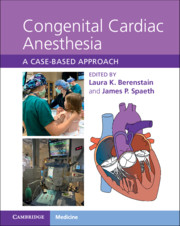Book contents
- Congenital Cardiac Anesthesia
- Congenital Cardiac Anesthesia
- Copyright page
- Dedication
- Contents
- Contributors
- Introduction
- Chapter 1 A Congenital Heart Disease Primer
- Section 1 Left-to-Right Shunts
- Section 2 Right-Sided Obstructive Lesions
- Section 3 Left-Sided Obstructive Lesions
- Section 4 Complex Mixing Lesions
- Chapter 21 d-Transposition of the Great Arteries (Arterial Switch)
- Chapter 22 d-Transposition of the Great Arteries (Atrial Switch)
- Chapter 23 l-Transposition of the Great Arteries (“Corrected” Transposition)
- Chapter 24 Total Anomalous Pulmonary Venous Return and Heterotaxy Syndrome
- Chapter 25 Truncus Arteriosus
- Section 5 Single-Ventricle Physiology
- Section 6 Heart Failure, Mechanical Circulatory Support, and Transplantation
- Section 7 Miscellaneous Lesions and Syndromes
- Index
- References
Chapter 25 - Truncus Arteriosus
from Section 4 - Complex Mixing Lesions
Published online by Cambridge University Press: 09 September 2021
- Congenital Cardiac Anesthesia
- Congenital Cardiac Anesthesia
- Copyright page
- Dedication
- Contents
- Contributors
- Introduction
- Chapter 1 A Congenital Heart Disease Primer
- Section 1 Left-to-Right Shunts
- Section 2 Right-Sided Obstructive Lesions
- Section 3 Left-Sided Obstructive Lesions
- Section 4 Complex Mixing Lesions
- Chapter 21 d-Transposition of the Great Arteries (Arterial Switch)
- Chapter 22 d-Transposition of the Great Arteries (Atrial Switch)
- Chapter 23 l-Transposition of the Great Arteries (“Corrected” Transposition)
- Chapter 24 Total Anomalous Pulmonary Venous Return and Heterotaxy Syndrome
- Chapter 25 Truncus Arteriosus
- Section 5 Single-Ventricle Physiology
- Section 6 Heart Failure, Mechanical Circulatory Support, and Transplantation
- Section 7 Miscellaneous Lesions and Syndromes
- Index
- References
Summary
Truncus arteriosus is a rare form of cyanotic congenital heart disease in which the embryologic separation of the arterial trunk remains incomplete. The primary anatomic lesion is a common arterial trunk that supplies the pulmonary, coronary, and systemic circulations. Patients become symptomatic early in infancy because pulmonary vascular resistance falls over the first days to weeks of life, resulting in pulmonary overcirculation. Ideally, truncus arteriosus repair occurs within the first weeks of life. The most common extracardiac congenital malformations associated with truncus arteriosus are those within the heterogeneous spectrum of 22q11 deletion syndrome. Features of 22q11DS can pose multiple challenges to anesthesiologists. Dysmorphic facies, including micrognathia, retrognathia, palatal abnormalities, and laryngotracheomalacia, can impede airway management. This chapter describes the care of a child with repaired truncus arteriosus and 22q11 deletion syndrome for palatal surgery and the perioperative management considerations.
Keywords
- Type
- Chapter
- Information
- Congenital Cardiac AnesthesiaA Case-based Approach, pp. 178 - 186Publisher: Cambridge University PressPrint publication year: 2021

